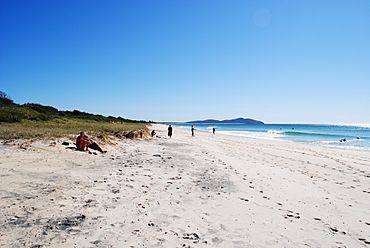Booti Booti National Park facts for kids
Quick facts for kids Booti Booti National ParkNew South Wales |
|
|---|---|
|
IUCN Category II (National Park)
|
|

A view of Seven Mile Beach, some of which is contained within Booti Booti National Park
|
|
| Nearest town or city | Forster-Tuncurry |
| Established | 1992 |
| Area | 15.67 km2 (6.1 sq mi) |
| Managing authorities | National Parks and Wildlife Service (New South Wales) |
| See also | Protected areas of New South Wales |
Booti Booti National Park is a beautiful national park in New South Wales, Australia. It's located about 282 kilometers (175 miles) north-east of Sydney. The popular holiday towns of Forster and Tuncurry are right next to the park. This park is a great place to explore nature and enjoy the coast.
Contents
History of Booti Booti National Park
The first European person to live in this area was Captain J. Gogerly. He sailed from Forster to Sydney, carrying loads of timber. Some members of his family are buried within the park.
From 1969 to 1975, people mined for minerals in the sand at Seven Mile Beach. Mining also took place at Elizabeth Beach from 1969 to 1970. The area was first made a state recreation area on September 30, 1977. Later, in 1992, it officially became a national park.
Geography and Landscapes
Booti Booti National Park has three main hilly areas. To the north, there's Cape Hawke, which is 224 meters (735 feet) high. In the southern part, you'll find Booti Hill, which is 169 meters (554 feet) high, and Charlotte Head, at 96 meters (315 feet) high.
These three hilly spots are connected by flat, sandy areas. These sandy areas were formed by rivers and wind. The land between Cape Hawke and Booti Hill is about 10 kilometers (6 miles) long. It ranges from 400 meters (1,300 feet) to 3.25 kilometers (2 miles) wide. This strip of land separates Wallis Lake from the ocean. Cape Hawke and Charlotte Head were once islands. Over time, sand built up and connected them to the mainland.
Plants and Flora
Booti Booti National Park is home to many different plants. There are 654 types of native plants found here. These plants grow in 46 different plant communities within the park. About 17% of the park is covered by rainforest.
The park also has seven types of wet sclerophyll forest and ten types of dry sclerophyll forest. Sclerophyll forests are known for their tough, leathery leaves that help plants survive dry conditions.
Threatened Plant Species
Five plant species in the park are considered threatened by the New South Wales Government. These include Allocasuarina defungens, A. simulans, Chamaesyce psammogeton, Cynanchum elegans, and Senna acclinis. Protecting these plants is very important.
Introduced Plants
Unfortunately, 104 types of plants that are not native to the park have been found. Some of these, like Bitou bush (Chrysanthemoides monilifera var. rotundata), have spread from nearby beaches. They have taken over sand dunes and cliff areas.
Lantana camara is another plant that has spread into the rainforest at Cape Hawke. It often grows in areas that have been disturbed. Other climbing plants like Madeira vine (Anredera cordifolia) and coast morning glory (Ipomoea cairica) can grow over and smother the native plants in the park.
Animals and Fauna
Booti Booti National Park is a great place for birdwatching. A total of 210 different types of birds have been seen within the park's boundaries.
Activities to Enjoy
There are many fun things to do at Booti Booti National Park:
- Hiking: Explore the park's walking trails.
- Swimming: Enjoy a dip in the ocean or lake.
- Birdwatching: Look for the many different bird species.
- Whale Watching: During winter, you might spot whales migrating along the coast.
If you want to stay overnight, there are camping sites at The Ruins. These are located in the Booti Hill area, at the southern end of the park. You can also visit the lookout on top of Cape Hawke for amazing views.
See also
 In Spanish: Parque nacional Booti Booti para niños
In Spanish: Parque nacional Booti Booti para niños


